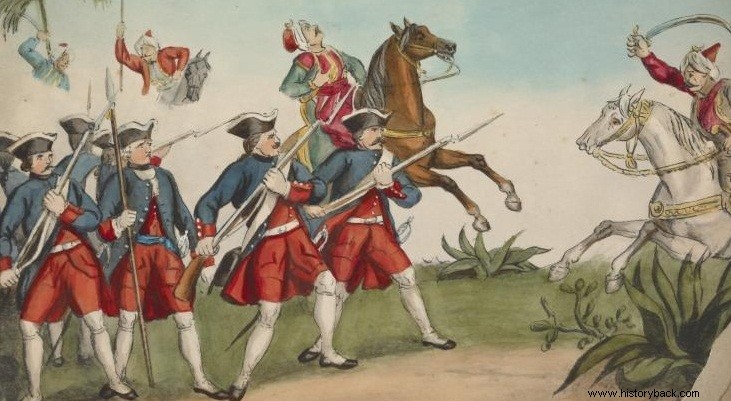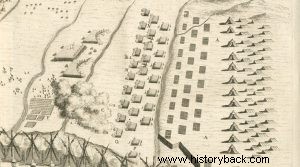
In 1684 the Venetians declared war on the Turks. Under Francesco Morosini the Venetians had significant successes from the start as the Turks fought hard against the Austrians and Poles in parallel. The Greeks in the Peloponnese were already in a revolutionary upheaval, a fact that the Turks realized by proceeding, as usual, with massacres. One of their victims was the metropolitan of Corinth Zacharias.
In Mani, it did not take long for an almost open rebellion to break out, asking for the reinforcement of the Venetians. In response, Ismail Pasha, the serasker of the Peloponnese, invaded Mani at the head of 10,000 men and began to burn and slaughter. The Maniates reacted and in a battle that took place they killed about 1,800 Turks.
In February–March 1685 Morosini sent arms and ammunition to the Maniates, but did not send reinforcements. On June 21, 1685, however, the Venetian fleet sailed from the Ionian Islands to the Peloponnese , also transporting a force of 8,000 (Sathas states 9,500) soldiers.
Crown
The small Venetian army arrived in the Peloponnese and after consultation it was decided to besiege the fort of Koroni. There was a strong garrison in the city and the Ottoman inhabitants were determined to defend themselves. After all, they were well supplied with food and ammunition.
Over the next two days the besiegers dug the first siege trenches. Three gun emplacements were created with a total of 50 guns coming mainly from the ships of the fleet.
The Turks defended fanatically from the beginning. They even made a sortie attacking Morosini's Dalmatian corps. It is worth noting that the men of the Venetian general were mainly Germans, from Saxony, Braunschweig and other German states, as well as Knights of St. John from Malta.
In the meantime, the Turks formed a liberating army, under Halil Pasha and Mustafa Pasha, with the aim of lifting the siege of Korona. The Turkish liberation army camped on an adjacent hill behind the besiegers' camp and began to harass them with raids.
In response, the Venetians built a rampart reinforced with a moat at the bottom of their camp to monitor the Turks, placing 100 soldiers as a guard. In the meantime the Turks of the city attacked the Venetian trenches but were repulsed. At the same time, 800 men of the two fronts attacked the newly-constructed bastion but they too failed.
Then the two pasades attempted to reinforce the besieged. For this purpose they formed a detachment of 4,000 men attempting to pass through the Christian camp. But they were repulsed with losses.
Nevertheless, the siege was not progressing pleasantly for the Christians as all their attempts against the city had failed. An attempt to undermine the walls also did not work. On the contrary, the Turks attacked with very strong forces, captured the bastion and massacred the 100 men of the garrison.
Counterattack
But Morosini immediately counterattacked. With his dragoons as vanguard, supported by the Dalmatians and the Knights of Saint John, the Christians swept away the vast majority of the Turks and recaptured the fortress. At least 300 Turks were killed.
De Morosini ordered the heads of 120 dead Turks to be cut off and placed on spears opposite the walls of Koroni so that the besieged Turks could see them.
In the meantime the Greeks had been emboldened by the presence of a large regular European army and began to rise again. The Maniates only reinforced Morosini with 1,500 warriors. Following this and wanting to end the two-front struggle in order to concentrate on the siege, Morosini decided to make a surprise attack on the Turkish camp of Halil and Mustafa.
On August 25, Morosini embarked 3,000 elite men on board the ships and disembarked on the right of the Turkish camp. This body moving through a valley approached stealthily. At the same time Morosini's main body marched against the Turks.
Three cannon shots gave the signal and the Christian forces simultaneously attacked the sleeping Turks, dispersing them. The terrified Turks fled, abandoning all their baggage, supplies, cannon, and banners.
Supply
After this the Christian army prepared to attack Koroni. On August 31, everything was ready. The besiegers had built a new sewer, in which they placed 250 barrels of gunpowder, which they successfully detonated causing a large breach in the wall.
Immediately the Christian infantry rushed out. But the Turks resisted fiercely, led by a mufti holding a Koran and exhorting them to 'witness the prophet' . About 400 Christians were killed and as many were injured in this first attack.
On the other hand, the Turks also lost the fanatic mufti and many of their officers. So when a new raid was carried out the Turkish defense collapsed. The soldiers entered the city and massacred at least 3,000 people. also the 120 cannons of the city were taken over.
The battle of Kalamata
After Koroni, Morosini sent the Maniates to occupy the fortress of Zarnata which was surrendered by treaty . At Zarnata Morosini was reinforced with 3,000 tough Saxon soldiers and marched towards Kalamata.
A Turkish army of 10,000 infantry and 2,000 cavalry had gathered there. The Turks had camped with their backs to the city. In the meantime the Christian army – 8,000 regular soldiers, 1,500 Manias – landed in the border area under the orders of German general Hannibal von Degenfeld , veteran of the battle of Vienna (1683).
The experienced German advanced towards the Turkish positions with the vanguard of his indefatigable dragoons, the heroic Maniates and Dalmatians. He placed the Venetian regiments in the center, on the right flank the Germans from Braunschweig and on the left flank the Saxons.
The head of the Turks was Kapudan Pasha himself (fleet admiral). In the meantime the Christian army had arrived near the Turkish camp. But he stopped by deploying on a range of low hills, with the ships of the fleet supporting the Saxons.
In the meantime, the Turks, seeing that the Christian left flank had no cavalry, attacked with their own. The Saxons, however, cut down the Spachians with their heavy fire, while the ships' cannons were spreading death among the Turks.
While this was happening on the Christian left, on the right Kapudan Pasha threw almost the entire infantry against the Braunschweig corps . And there, however, the disciplined Germans, although they were dramatically outnumbered, crushed the Turks with continuous volleys. Having been defeated on both wings, the Turks could not withstand the Christian counterattack.
The Turks gave up and fled to Kalamata. However, their morale was so low that after destroying guns and ammunition they left the city. After this victory, the Maniates also captured the castles of Oitylus, Kelefas and Pasavas. They were the first major victories in the Peloponnese. Others would follow.

The battle of Kalamata. The Christian army can be seen ready for battle with the ships supporting it.
